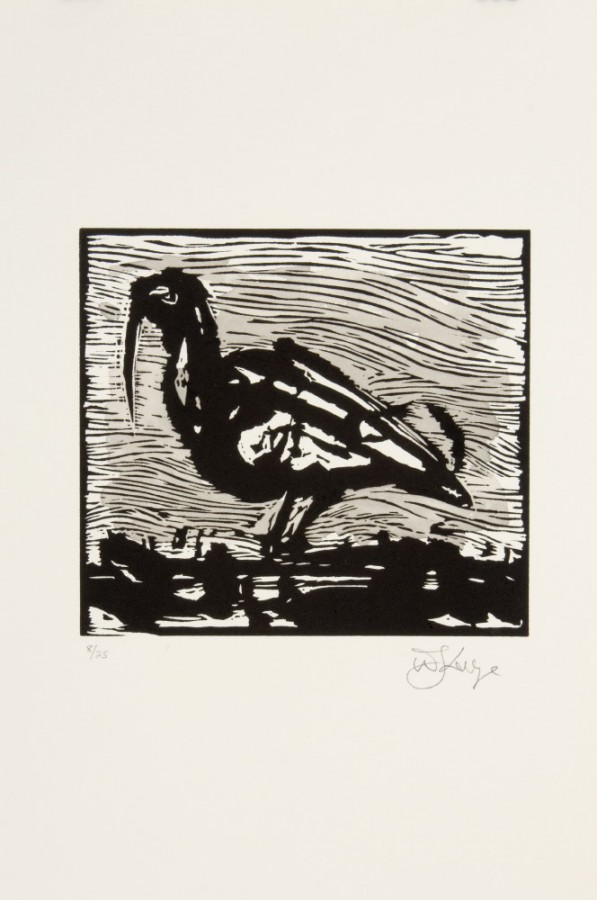2010 Linocut: Hadeda
Hadeda is one of a small series of six linocuts – the others being Splash, Portrait, Rumours, Solo for Bicycle and Floral Dress – created at the David Krut Workshop in 2010. Despite the scarcity of linocuts in Kentridge’s oeuvre up until this point, one of the first prints he made in 1976 after finishing high school was a linocut: an image of his grandfather in a deck chair wearing a three-piece suit while on holiday in Muizenberg, just outside Cape Town. Although the extent of the facilities available to Kentridge at the time was limited to “lino, cartridge paper and the back of a spoon”, he has cited the image as one of the sources for the character, Soho Eckstein, who first appeared in Kentridge’s 1989 film, Johannesburg: 2nd Greatest City After Paris and is the main protagonist in the Drawings for Projection cycle of nine films made between 1989 and 2003.
Kentridge returned to linocut in 2000, for the creation of the monumental pair of linocuts, Walking Man and Telephone Lady, and comes back briefly to the medium in this group of prints, perhaps as groundwork for the large-scale linocut project, the Universal Archive series of linocuts that he embarked on with the David Krut Workshop in 2012.
The polymathic nature of Kentridge’s practice allows any selection of work to always contain traces of projects past or yet to come, as well as a particular sensitivity to medium. This cluster of six linocuts were all created during the course of 2010 and reference Kentridge’s production of The Nose opera in March 2010; his 2010 exhibition in the Egyptian Collection wing of the Louvre; work towards The Refusal of Time, a collaborative video installation realised at Documenta 13; and, perhaps most significantly, the return of Soho Eckstein in an animated film, Other Faces, premiered in May 2011 at Kentridge’s exhibition at Marian Goodman Gallery in New York.
Hadeda depicts an ibis, “hadeda” the name used in South Africa to refer to the ibis, in mimicry of its distinctive cry. The ibis also has strong links to ancient Egypt, where it was associated with the god, Toth. One of the principal gods in the Egyptian belief system, Toth was thought to be the heart – the seat of intelligence for ancient Egyptians – and tongue of the sun god, Ra, and the means by which Ra’s will was translated into speech. In Kentridge’s oeuvre the image of the hadeda first appeared in a photogravure print (depicting Kentridge as a scribe) that he made with Master Printer Randy Hemminghaus in 2010. The image formed part of Kentridge’s work on the project he did for the Louvre in the same year, called Carnets d’Egypte (Egyptian Sketchbooks). For this exhibition, Kentridge made 16 short films that were shown in the Egyptian Collection wing of the Louvre. The drypoint print titled Scribe, which was made in collaboration with DKW, also references this photogravure image.
| Artist: | William Kentridge |
| Title: | 2010 Linocut: Hadeda |
| More about: | William Kentridge |
| Year: | 2010 |
| Artwork Category:: | Editions & Multiples published by David Krut |
| Media & Techniques: | Hand-Painting, Linocut |
| Edition Size: | 25 |
| Sheet Height: | 47.5 cm |
| Sheet Width: | 32 cm |
| Availability: | Not Currently Available |
| Framing: | Unframed |
| Artwork Reference: | 1581 |
